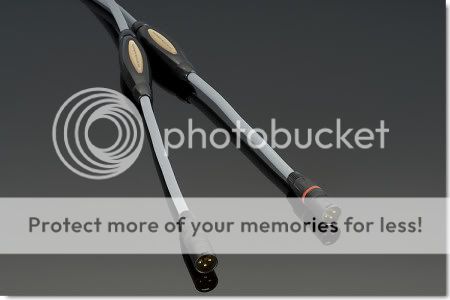 For Sale Hi-end Transparent Musiclink Plus Balanced Interconnect........
For Sale Hi-end Transparent Musiclink Plus Balanced Interconnect........
Hi-end Transparent Musiclink Plus Balanced Interconnect........
MusicLink Plus Balanced Interconnect
Balanced Plus is a true differentially balanced cable with 2 precision balanced networks neatly housed in a single network module. It delivers deeper, tighter bass and suppresses noise more effectively than balanced cables without networks.
SPECIFICATIONS
* Standard termination: XLR > XLR
* Lengths: 1 meter, 1.5 meter, 2 meter, 10 feet, 15 feet, 20 feet, 25 feet
* Custom terminations/lengths/singles always available.
* Adaptors: XLR > RCA, XLR Y, RCA Y
As far as price is concerned, the MusicLink Plus interconnect falls smack in the middle of Transparent's line of five single-ended interconnects. The MusicLink Plus is MusicLink Plus Interconnectconstructed around a pair of conductors composed of several 99.999% OFHC copper strands wound around a Teflon dielectric center core. As with the MusicLink (non Plus) interconnect that I also have on hand, the Plus contains a module which houses a passive filter network designed to help reject, and filter out, noise injected into the cable from external electronic sources. In addition to the filter network, Transparent employs multiple layers of shielding in the MusicLink Plus to further decrease the likelihood of noise infiltration. Personally, I haven't been plagued with noise problems when using unshielded cables in my listening environment, but audiophiles who aren't so lucky will appreciate the strides Transparent Audio has taken to make their cables immune to them.
The MusicLink Plus is, physically, a much more substantial cable than Transparent's less-expensive MusicLink - the Plus' filter network is substantially larger, the cable is heavier gauge and better insulated, and termination is via a much higher-quality pair of RCA connectors.
While cable break-in is a hotly contested topic on Usenet newsgroups like rec.audio.high-end, I have found that cables do, in fact, change sonically over time and not always in insignificant ways. For that reason, the MusicLink Plus, and the other two cables reviewed here, were broken in for more than fifty hours before any serious listening was done.
Auditioning of the MusicLink Plus took place in my usual reference system, where it was used to connect the analog outputs of either the Theta DS Pro Progeny or Assemblage DAC-2 D/A converters to one of the line-level inputs of the Conrad Johnson Premier II preamp.
To get a handle on the Plus' sonic signature, comparisons were made with Transparent's own MusicLink interconnect and Stager Sound Systems' Silver Solids interconnect, a cable about which I'll have much more to say in the coming months.
Listening
Quite in common with the HDL digital cable reviewed below, the MusicLink Plus excelled at reproducing music's low frequencies. The immense bass drum in the last movement of David Zinman's rousing version of Rachmaninoff's Symphonic Dances (Baltimore Symphony Orchestra, Telarc CD-80331) had terrific impact and power, yet remained well-defined and controlled.
Lovers of the sound of a well-recorded drum kit (I definitely count myself among them), should run out and pick up Joe Morello's Morello Standard Time (DMP CD-506). This disc, engineered by DMP's resident genius, Tom Jung, contains some of the most natural drum sounds I've heard on record. The sound of Morello's low toms on Alone Together from this disc, exploded into the listening room via the MusicLink Plus to a degree which was unmatched in my experience. In addition to the power and dynamics of Morello's percussive performance, the different timbres of each drum and drum head were fully laid to bare by the superior resolving powers of the MusicLink Plus.
While the MusicLink Plus was powerful and dynamic in the bass, it was also refined and detailed. All of the detail in Christian McBride's solo bass performance on Night Train from Gettin' To It (Verve 314 523 989-2), was beautifully reproduced by the Plus - each subtle inflection of plucked and bowed string was easily discernible, as was each movement of McBride's body and upright bass, greatly adding to the illusion of reality.
Many more examples of the MusicLink Plus' bass prowess exist in my listening notes, but I won't bore you with the details. Suffice it to say that the MusicLink Plus raised the level of my reference system's bass performance to a new plateau.
Lower midrange body and texture were also well preserved by the MusicLink Plus. The sound of Janos Starker's cello on Mercury's lovely CD reissue of Dvorak's Cello Concerto in B minor Op.104 (Mercury Living Presence 432 001-2) had excellent body and tone, sounding convincingly woody and resonant. Moving higher in this frequency band, the massed chorus on Harmonia Mundi's award-winning recording of Brahms' Motets Op. 74, as performed by RIAS-KAMMERCHOR, was smooth yet powerful, the sound of the chorus exhibiting a certain "rightness" that could almost have been mistaken for the real thing. Only in the upper midrange did the MusicLink Plus exhibit a trace of hardness, which was evident, to varying degrees, on a selection of female vocal recordings. This slight upper midrange hardness was also evident with the less-expensive MusicLink but was not in evidence with Stager Sound Systems' Silver Solids interconnect. While it is possible that the slight upper midrange glare heard with both Transparent cables could have been a result of those cables faithfully reproducing recorded anomalies or problems in upstream components, the silky smooth, glare-free upper midrange of the Stager Sound Systems cables made a pretty compelling argument otherwise. I must emphasize that the Plus' midrange glare was quite minor and rarely detracted from my enjoyment of my favorite vocal recordings.
The MusicLink Plus' treble was detailed, smooth and extended, with no traces of glare or brightness. The triangle in the final movement of Rachmaninoff's Symphonic Dances was harmonically rich, with great sparkle and purity of tone. These same endearing treble qualities could be heard in the reproduction of cymbals, triangles and tambourines during Emmanuel Chabrier's Espa�a (Paul Paray conducting the Detroit Symphony Orchestra, Mercury Living Presence CD 434 303-2).
The MusicLink Plus was a very lively cable and exhibited excellent rhythm and pace. The talented guitar duo of Strunz and Farah make considerable use of complex and intricate rhythms on Americas (Mesa Records R2 79041) , all of which were faithfully communicated to the listener by the MusicLink Plus. The incredible forward momentum of Christian McBride's In A Hurry from Gettin' To It, was in no way diminished by the MusicLink Plus in the reproduction chain. In fact, the MusicLink Plus had far less of an editorial effect on rhythm and pace than the other cables I had on hand for comparison.
Finally, depth, imaging and soundstaging via the MusicLink Plus were all superb, rivaling the best I've heard in my system to date. Instruments occupied their own distinct physical space within a wide, deep soundstage and remained in that space regardless of changes in frequency or sound level. Instrumental outlines were precisely defined and realistically rendered by the MusicLink Plus, which imparted a you-are-there realness to the sound of small jazz, classical, and pop ensembles.
Comparisons between the MusicLink Plus and Transparent's less-expensive MusicLink turned up nothing unexpected - the MusicLink Plus bettered the MusicLink interconnect in almost every respect. The MusicLink Plus threw a wider, deeper soundstage, exhibited more precise imaging and had better dynamic abilities than the MusicLink. In addition, the Plus had a deeper, more extended bottom-end, a smoother, more liquid midrange, and a more extended, grain-free top-end. Given its clear superiority over the MusicLink, the MusicLink Plus is well worth the additional $100 and handily earned its 'Plus' designation in my system.
Conclusions
There are many well-respected cable companies manufacturing high-quality interconnects for use in high-end audio systems. I haven't had the opportunity, or time, to audition all of them and, therefore, I can't claim that the MusicLink Plus is the "best" in any sense of the word. What I can state with certainty, however, is that the MusicLink Plus is an excellent interconnect, one which contributed significantly to my listening pleasure over the last few months. The MusicLink Plus has terrific bottom-end weight, extension and definition, a smooth, liquid, nearly glare-free midrange, and an extended, detailed top end. As well, the MusicLink Plus has great dynamics, transient response, and soundstaging and imaging abilities.
Although the ideal cable will have no sonic signature of its own, this is rarely, if ever, achieved. In reality, we must content ourselves with the search for a cable which minimally degrades the audio signal it carries, and which faithfully communicates the musical message. Transparent Audio's MusicLink Plus is such a cable, and I highly recommend its audition to anyone in the market for a reasonably-priced, high-end interconnect.




|


